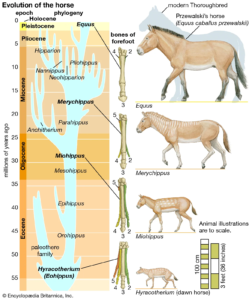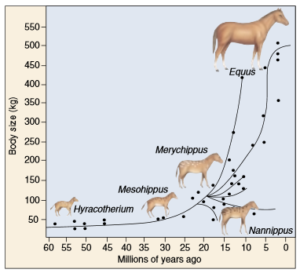Evolution of the Horse– The Most Complete Fossil Record
Written by: Claudia Kowal
Introduction
How did the small, dog-like creatures from millions of years ago evolve into the modern horses we know today? This question can be answered through the extensive excavation of horse ancestors’ fossils over the past several decades. While many other species’ lineages have gaps and holes in their fossil records, the equine fossil record can be soundly traced back to several different ancestors. The fossil record of equine evolution is currently recognized as the most complete record of Darwinian evolution, making it a prime model in evolutionary biology. From these records, the evolution of the horse can be broken down into five main genera, including the Eohippus (or Hyracotherium), Mesohippus, Merychippus, Pliohippus, and the Equus (the modern-day horse) (MacFadden et al., 2012). This article will discuss the history and potential reasons behind why these genera increased in size over time.
Figure 1

A diagram Equus and three of its ancestor genera.
Source: Britannica
Main Anatomical Differences
When comparing the fossils of Eohippus found in North America to the anatomy of the modern Equus, it is no secret that horses have drastically increased in size during their approximately 56 million years on Earth. In fact, the evolution of Equus is believed to be a prime example of an evolutionary concept called Cope’s Law, which proposes that species increase in size over multiple lineages (Roy et al., 2024). One study completed in 1986 at the University of Florida attempted to figure out exactly how, specifically by investigating when the Eohippus increased in size and mass (MacFadden et al., 2012).
The study used approximately 700 total fossil samples, consisting of 45 different species ranging from the Eocene to Pleistocene epochs (approximately from 66 to 3 million years ago) (Britannica, 2020). To compare past genera with current-day Equus, the study also collected data from 34 live individual horses from the University of Florida, College of Veterinary Medicine. The researchers first needed to get past an apparent issue; comparing the body mass of fossilized specimens and living beings is very unreasonable due to the deterioration of tissues overtime. After running a few trials, however, the researchers found that the most accurate method of this was measuring their teeth size.
The researchers created a regression model by comparing the age of fossils with the estimated body mass. This method not only allows them to observe changes in body mass over time, but also provides a model for estimating the body mass of any possible Equus ancestor fossils found in the future. As expected by Cope’s law, the regression model shows an exponential increase in Equus ancestor’s body mass over time. (MacFadden et al., 2012).
Figure 2

Graph of Equus and ancestors’ body size over millions of years.
Source: JSTOR
An Evolutionary Explanation
There are many different hypotheses as to why Equus increased in size over time, but one particularly popular idea involves the change in landscape, particularly across North America (Anderson, 2006). While there were many woodlands and heavy vegetation during the time of Eohippus, the land later evolved into short prairie grasslands with low vegetative coverage. This change in landscape made it more difficult for Equus ancestors to hide from predators, and as a result, the species had to compensate with speed. In terms of fleeing from predators, horses with the longest legs had the greatest likelihood of survival due to the advantage of having a longer stride. Accordingly due to natural selection, populations of smaller horses with shorter legs gradually decreased in number as they succumbed to their predators(McHorse et al., 2019).
Conclusion
Utilizing the extensive fossil record of Equus ancestor genera, scientists were able to uncover information about this animal and support current beliefs that the current landscape had a significant influence in Equus evolution. From just this one fossil record, it is clear how fossils are essential to our understanding of evolution; they can help fill in gaps in the tree of life. Additionally, through the creation of studies and models, like the one mentioned above, simple pieces of evidence like fossils can be used to determine more complex aspects of anatomy, like body mass and its distribution of now-extinct species.
References and Sources
Anderson, R. C. (2006). Evolution and origin of the Central Grassland of North America: climate, fire, and mammalian grazers1. The Journal of the Torrey Botanical Society, 133(4), 626–647. https://doi.org/10.3159/1095-5674(2006)133[626:eaootc]2.0.co;2
Britannica. (2020). Eocene Epoch | geochronology | Britannica. In Encyclopædia Britannica. https://www.britannica.com/science/Eocene-Epoch
MacFadden, B. J. (1986). Fossil Horses from “Eohippus” (Hyracotherium) to Equus: Scaling, Cope’s Law, and the Evolution of Body Size. Paleobiology, 12(4), 355–369. https://www.jstor.org/stable/2400511?seq=11
MacFadden, B. J., Oviedo, L. H., Seymour, G. M., & Ellis, S. (2012). Fossil Horses, Orthogenesis, and Communicating Evolution in Museums. Evolution: Education and Outreach, 5(1), 29–37. https://doi.org/10.1007/s12052-012-0394-1
McHorse, B. K., Biewener, A. A., & Pierce, S. E. (2019). The Evolution of a Single Toe in Horses: Causes, Consequences, and the Way Forward. Integrative and Comparative Biology, 59(3). https://doi.org/10.1093/icb/icz050
Roy, S., Brännström, Å., & Dieckmann, U. (2024). Ecological determinants of Cope’s rule and its inverse. Communications Biology, 7(1), 1–10. https://doi.org/10.1038/s42003-023-05375-z